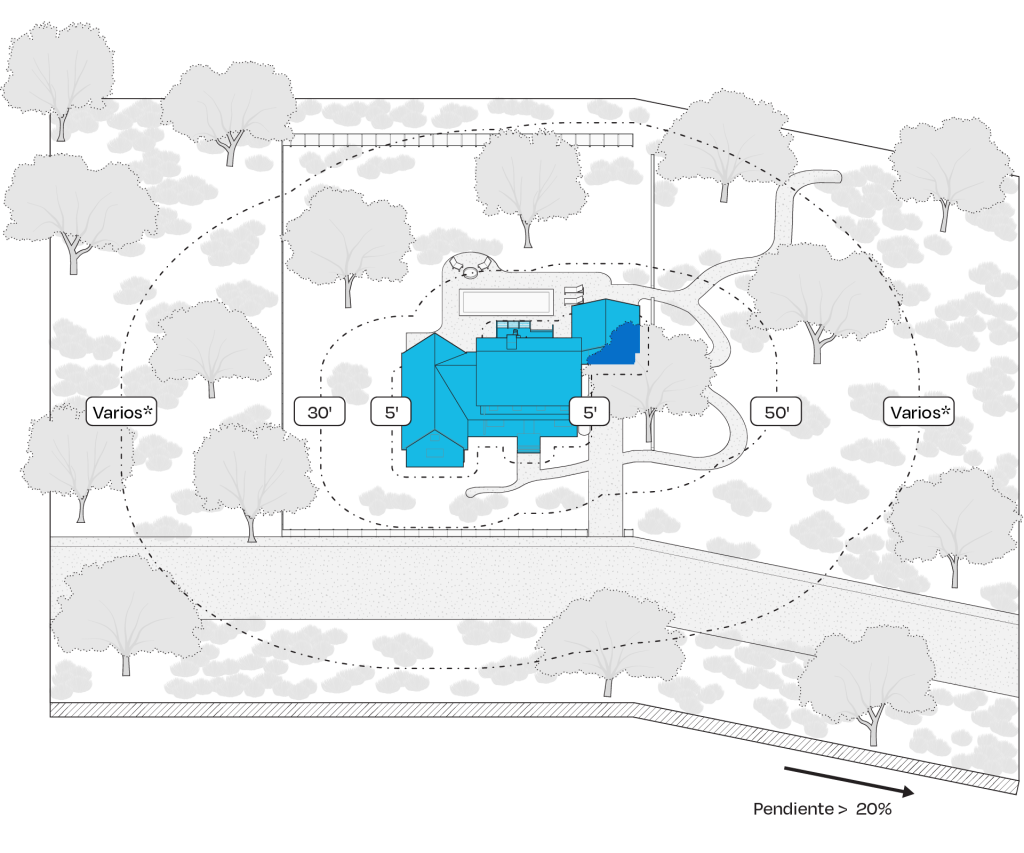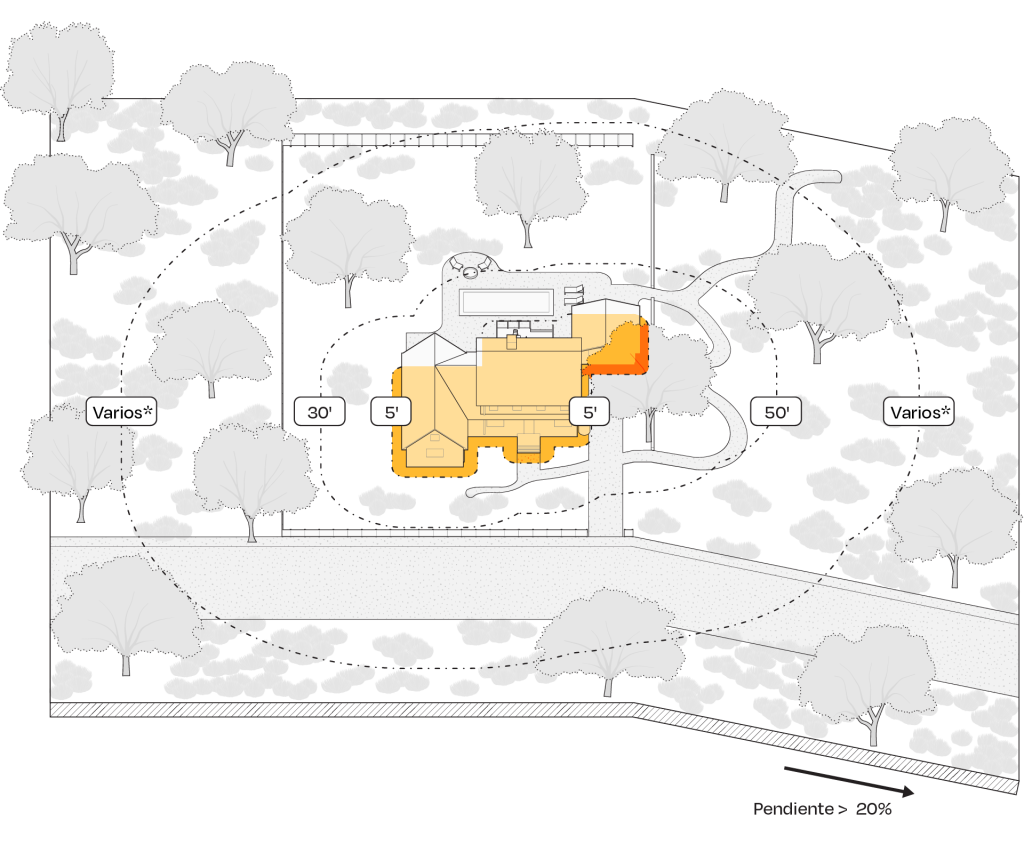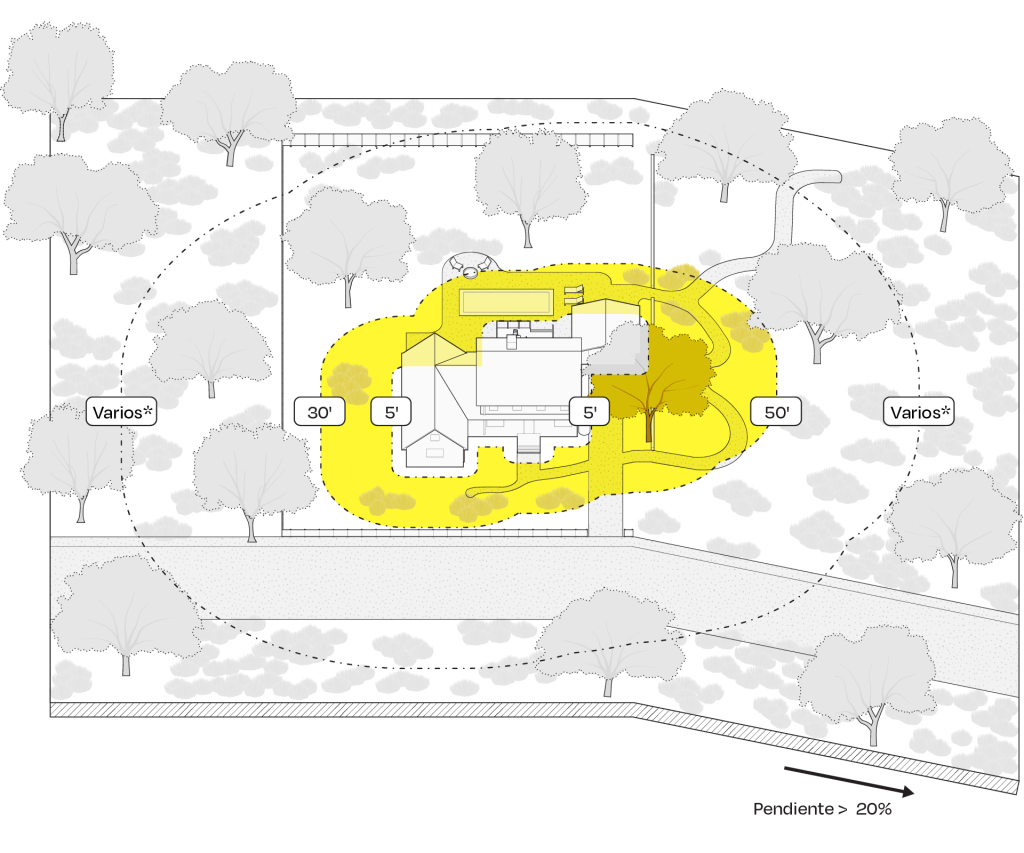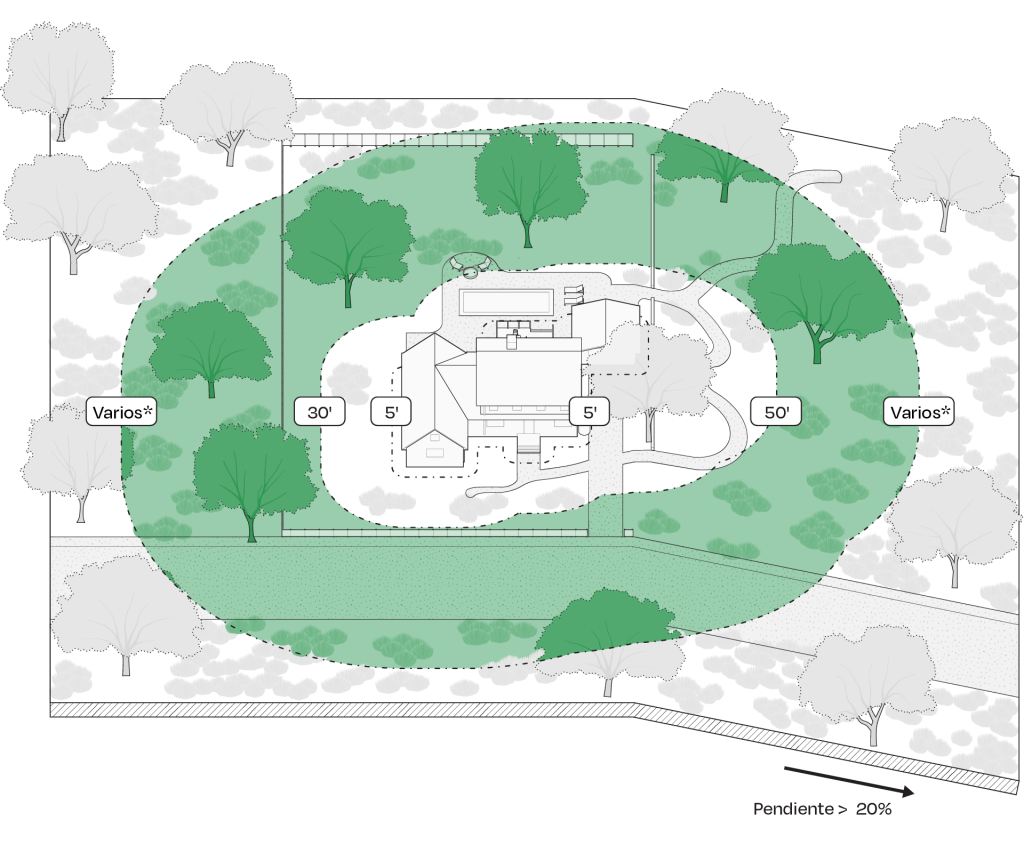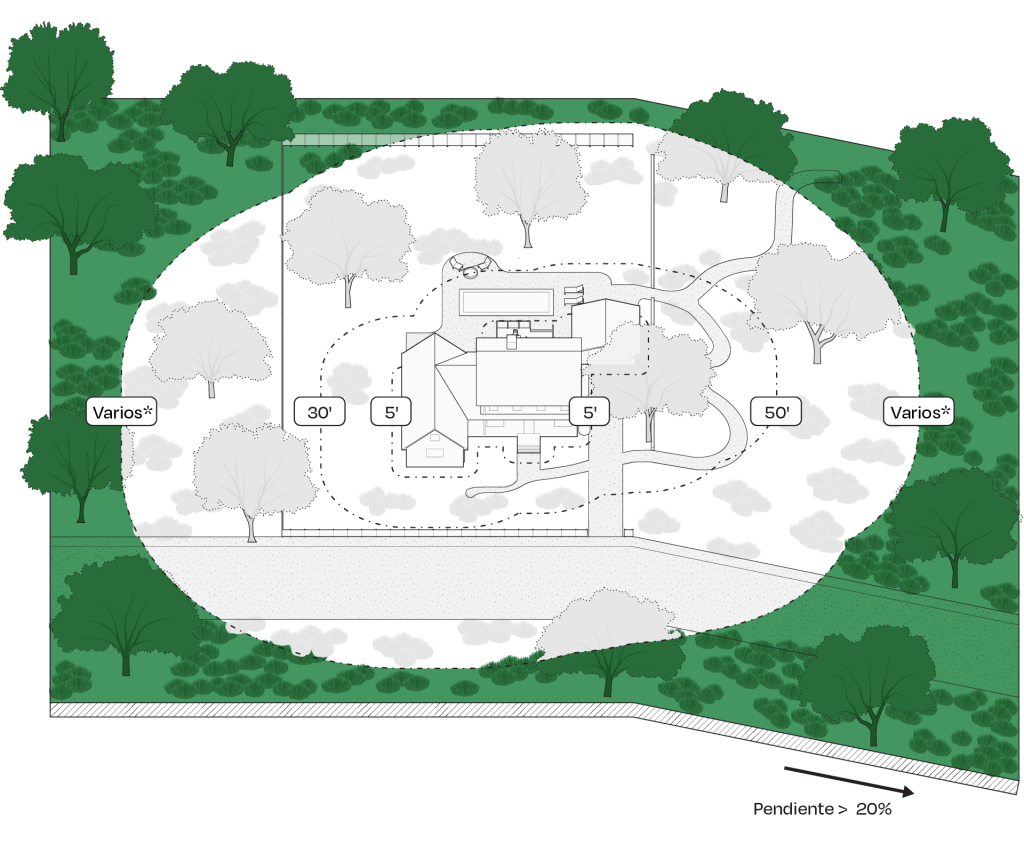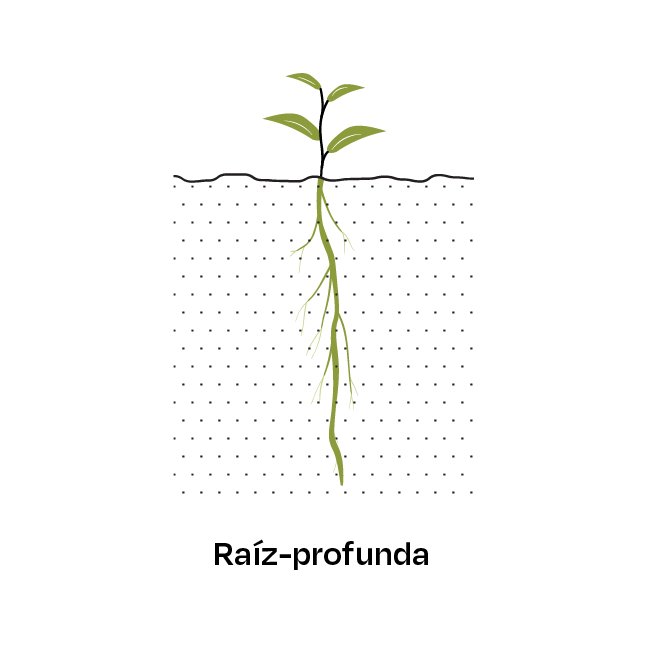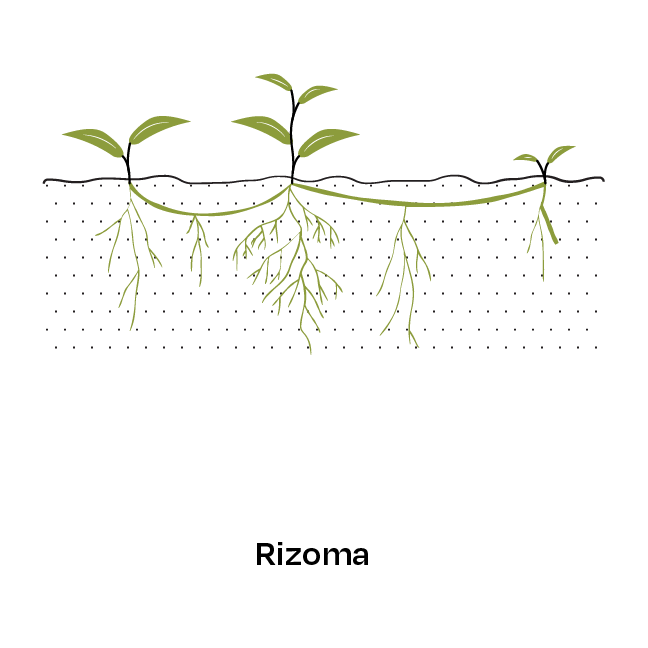LANDSCAPE (NEW)
Wildland Fire Safety Starts at the HOUSE
Fire safety in the wildland-urban interface (WUI) starts at the home, with the use of fire-resistant building materials and architectural features, good maintenance practices to avoid ember ignitions that could start fires in and around the house, and a good fire response plan for your family. You can find all the the information about home hardening in this section of our website.

* The size of the zones shown above are supported by research into home losses in wildfires, and are consistent with most local regulations at the time of publication. Based on this evidence and current CalFire standards, we show a maximum distance for native vegetation modification of 100′ from the house. However, the type of vegetation, terrain, and local regulations may require additional thinning beyond 100′. The Los Angeles County Fire Department may require up to 200’ of defensible space. Contact your local Fire Department for specific requirements.
Native vegetation is often protected by regulations, so do not remove previously unmodified habitat without first contacting your local County planning department for specific limitations and processes.
If you are neighboring a State Park or Protected Area, you may apply for a Boundary Vegetation Modification Right of Entry Permit (BVMROE) to address your desired defensible space. An approved permit allows homeowners or their contractor access to State Park land to trim vegetation within 130 feet of the closest habitable structure. To learn more about obtaining a State Parks BVMROE permit to complete defensible space for your home, contact California State Parks at info@parks.ca.gov.
Recommendations
Beyond the home, the following sections will help you implement fire-wise landscaping practices where plants and hardscape are selected and maintained so that they do not transmit fire. Establish your defensible space so that the risk of fire transmission to your property is reduced, and fire fighters can safely protect your home.
Fire is a part of the natural environment in Southern California. If you live in the wildland-urban interface (WUI, check our maps in the Location section), there will always be the potential for wildfire. It is not a question of IF a fire will occur, but WHEN. Preparation for wildfire requires that YOU take responsibility for your safety, property, and pets in the event of a fire. Maintain your property to reduce the risk of damage during a wildfire, and be fully prepared to evacuate.
The Ember-Resistant Zone (ERZ)
The Ember-Resistant Zone, commonly referred to as Zone Zero, is the first 5 feet around your home, starting at the structure itself. The objective in this zone is to avoid ignitions from windblown embers landing on or near the direct surroundings of the house and starting a fire. Ember ignitions are responsible for the majority of homes lost or damaged in wildfires. In the Ember-resistant Zone, all home building materials, equipment, outdoor furniture, toys, dead vegetation or anything else that could be ignited by embers should be removed or replaced. Research from the Insurance Institute for Business and Home Safety (IBHS) shows that the first 0 to 5 feet around the house has the greatest impact on reducing the risk of losing a home to wildfire.
Creating your Zone Zero ember resistant zone does NOT mean mature native trees must be removed.
- On the contrary, healthy, mature trees can effectively block flying embers, and can help maintain a cool, wetter microclimate around your home.
Embers are most dangerous when they land on the ground near a house/structure, or on surfaces such as gutters and roofs. Embers may also cause ignition if there is combustible material on the ground level such as wood mulch, dry/dead plant material, or other combustible items.

* The size of the zones shown above are supported by research into home losses in wildfires, and are consistent with most local regulations at the time of publication. Based on this evidence and current CalFire standards, we show a maximum distance for native vegetation modification of 100′ from the house. However, the type of vegetation, terrain, and local regulations may require additional thinning beyond 100′. The Los Angeles County Fire Department may require up to 200’ of defensible space. Contact your local Fire Department for specific requirements.
Native vegetation is often protected by regulations, so do not remove previously unmodified habitat without first contacting your local County planning department for specific limitations and processes.
If you are neighboring a State Park or Protected Area, you may apply for a Boundary Vegetation Modification Right of Entry Permit (BVMROE) to address your desired defensible space. An approved permit allows homeowners or their contractor access to State Park land to trim vegetation within 130 feet of the closest habitable structure. To learn more about obtaining a State Parks BVMROE permit to complete defensible space for your home, contact California State Parks at info@parks.ca.gov.
Recommendations
 |
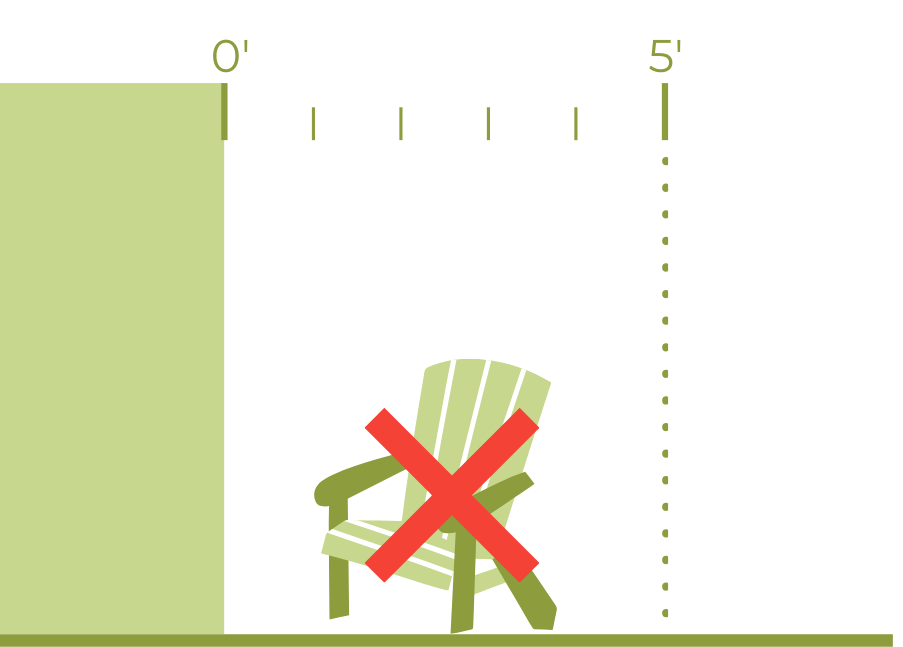 |
No dead vegetation or household objects are recommended within 5 feet of any structure |
||
 |
 |
Keep surrounding area of your structures clear of combustible materials |
||
 |
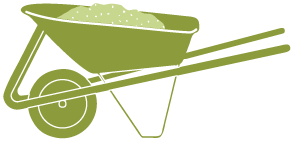 |
Install hard surfaces, such as concrete walkways, or use noncombustible mulch products such as rocks and gravels |
||
 |
 |
Maintain a 5-foot zone free of dead plant materials |
||
 |
 |
Include footprint of any attached structure, such as a deck, within the Ember-Resistant Zone |
||
 |
 |
Keep 6 inches of non-combustibility above ground at the base of your walls to prevent ignition of the siding. Hardscaping is strongly recommended around the base of structures |
Plant Selection
Mature healthy trees can effectively block flying embers in the ember-resistant zone.
 Mulch
Mulch
- Wood mulch is not recommended within the ember-resistant zone
- Instead use inorganic mulch such as rocks and gravel
- Do not use rubber or plastic based mulch. Rubber mulch produces very high temperatures and flames when ignited. It ignites easily and burns intensely for a prolonged period. Click here for U-Nevada study on mulch combustibility.
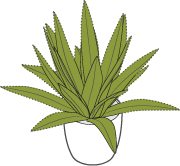 Potted Plants
Potted Plants
Potted plants should be well-maintained and follow these guidelines. We recommend keeping heavy potted plants outside this zone since heavy pots can be hard to move.
- Do not plant invasive species. They can generate seeds and contaminate the natural environment. Click here for INVASIVE section.
- Make sure your potted plants are well maintained and watered all year on.
- Remove any debris and dead material from your potted plant. Any leaf litter within the pot can be ignited by embers.
 Ground Cover
Ground Cover
Irrigated vegetation, so long as it is maintained may remain in Zone 0.
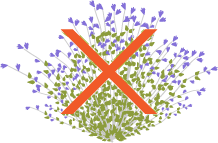 Shrubs
Shrubs
Not recommended in Zone 0
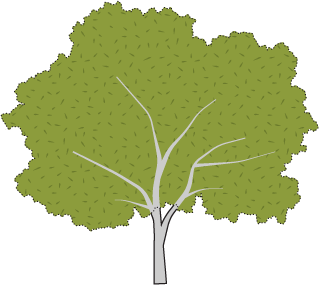 Trees
Trees
- Mature healthy and maintained trees may remain in the Ember-Resistant Zone
- For existing trees, refer to the UPGRADE tab for this zone
Typical Amenities in Zone 0


- Make sure the amenities are movable, not in contact with your structure (ideally outside the 5-foot zone) and with a minimum of 12 inches vertical space from any window.
- For non-movable amenities (e.g. rain barrels) make sure they are made of non combustible material (e.g. metal).
- Any amenities should be movable and placed outside the Ember-Resistant zone during Red Flag Warnings. Click here for CAL FIRE Current Emergency Incidents page.
Typical Accessories in Zone 0


If you have combustible accessories such as awnings, shades / cabanas, play-sets, or decks, make sure to extend your ERZ and include 5 feet of non-combustible area around these structures.
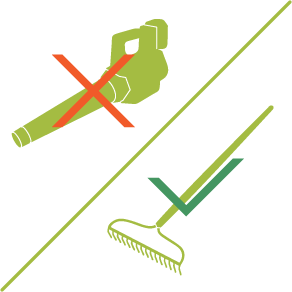 About Leaf Blowers
About Leaf Blowers
In early summer, give your leaf blower a vacation; use a rake instead. Leaf blowers blow away mulch and topsoil, and they contribute to air and noise pollution. They are also a fire hazard due to engine heat and the sparks they can generate. The use of gas powered leaf blowers is prohibited within 500 feet of a residence at any time within the City of Los Angeles. Electric leaf blowers are allowed.
Defensible space is the area between your home and an oncoming wildfire. All vegetation, including native plants and ornamental plants, are potential fire fuel. Through proper planning, you can have both a beautiful native landscape and a fire-wise home. Fire-wise landscapes should also include hardscape, such as granite paths and stone walls. These can act as fuel break -in-between islands of native vegetation– and help to slow down or change the path of an approaching fire.
The Home Protection Zone
The Home Protection Zone should be designed to create and maintain a landscape that, if ignited, will not transmit fire to the home. Depending upon the type of wildland vegetation in the area and the steepness of the slope, this zone should have an area at least 30 feet wide (50 feet for slopes above 20%) that is lean, clean, and green. Trees should be spaced to allow min 10’ clearance to structure at full maturity.
The Home Protection Zone should be designed to promote fire-wise landscaping and water conservation. It is a recommended minimum planting zone starting with low-density planting to medium-density as you move outward from the house. The goal is to create a low-ignition landscape capable of slowing down fire spread. Plants that are green and lush give better protection. If regularly watered and pruned to remove dead or unhealthy material, these plants will be far less likely to carry fire to your home. While all plants will eventually burn, healthy ones with a high moisture content are more difficult to ignite.
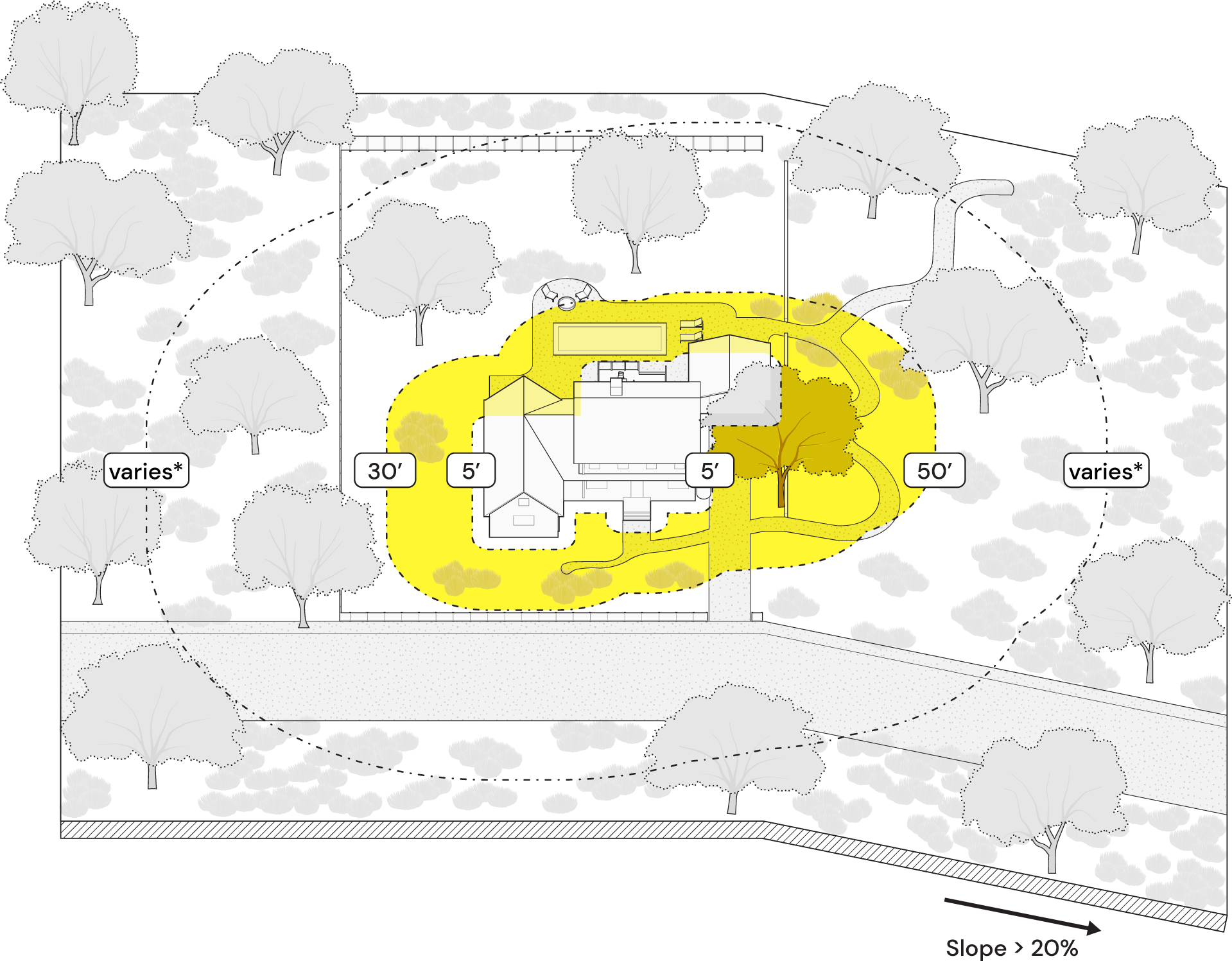
* The size of the zones shown above are supported by research into home losses in wildfires, and are consistent with most local regulations at the time of publication. Based on this evidence and current CalFire standards, we show a maximum distance for native vegetation modification of 100′ from the house. However, the type of vegetation, terrain, and local regulations may require additional thinning beyond 100′. The Los Angeles County Fire Department may require up to 200’ of defensible space. Contact your local Fire Department for specific requirements.
Native vegetation is often protected by regulations, so do not remove previously unmodified habitat without first contacting your local County planning department for specific limitations and processes.
If you are neighboring a State Park or Protected Area, you may apply for a Boundary Vegetation Modification Right of Entry Permit (BVMROE) to address your desired defensible space. An approved permit allows homeowners or their contractor access to State Park land to trim vegetation within 130 feet of the closest habitable structure. To learn more about obtaining a State Parks BVMROE permit to complete defensible space for your home, contact California State Parks at info@parks.ca.gov.
Recommendations
 |
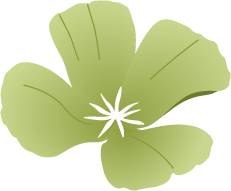 |
Plant primarily native species within Zone 1 and 2. Native plant species support local ecosystems and wildlife. Click here for information about native plants. |
||
 |
 |
Non-native plant species that are not invasive may be allowed, although we recommend using primarily native species. Remove invasive plants. Click here for list of invasive plant species. |
||
 |
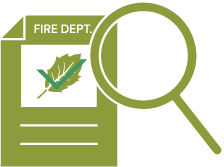 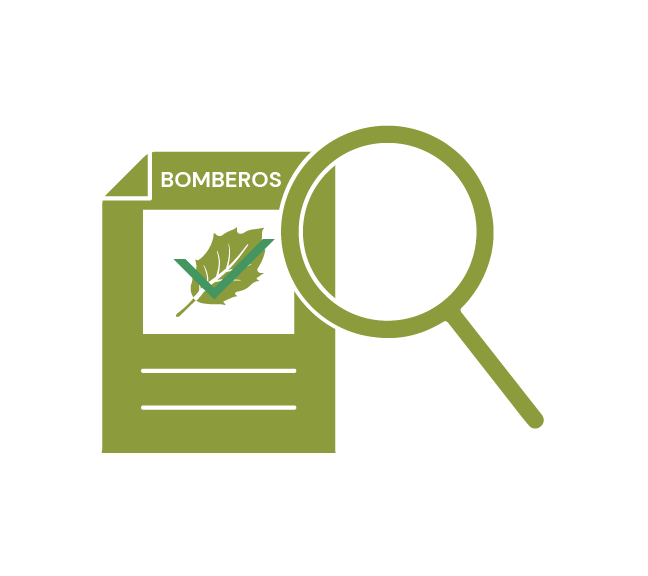 |
Plant species used within this zone should be consistent with Fire Department requirements. |
||
 |
 |
Prefer ground covers and shrubs with occasional small tree. |
||
 |
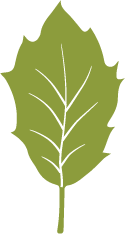 |
Plant tree that do not exhibit flammable characteristics. Click here to learn what makes a plant flammable. |
||
 |
 |
Create a drip irrigation system to promote water conservation and promote well maintained plants. Click here for information about irrigation systems. |
Plant Selection
Climate-appropriate Leaf Characteristics

California native plants have evolved over time to thrive in our unique and varied climate conditions. By learning to recognize their adaptation tricks, you can identify climate-appropriate plants wherever you are. These four characteristics will allow you to find climate-appropriate plants in a crowded nursery.
- Stiff, Leathery: These leaves hold on to water and stay evergreen for most of the year.
- Silver or Hairy: Light colored leaves reflect sunlight, cooling the plant. Hairy back sides of leaves hold moisture longer, cooling them off.
- Tiny or Little: Small leaves are like tiny solar panels that are easier to keep cool than one large hot surface.
- Solar Tracking: Leaves that appear to be standing at attention, straight up and down in the middle of the day, are solar tracking. As the day progresses, or if you see the same plant in the early morning, you will find that the leaves are more horizontally oriented. This plant is moving its solar panels to minimize the hottest sun exposure. California native manzanitas (Arctostaphylos) are notorious for this adaptation.
Click here for more information about California native plants.

Mulch
The use organic mulch is allowed within the Home Protection Zone.
- Prefer composted wood-chips from tree trimmings and plant material, it screens off weeds when applied as a layer 2” to 4” thick, reduces evaporation from the soil surface, cuts watering needs and promotes soil microorganism activity.
- Do NOT use rubber or plastic based mulch. Rubber mulch produces very high temperatures and flames when ignited. It ignites easily and burns intensely for a prolonged period. Learn more about the combustibility of different types of landscaping mulch here.
 Ground Cover
Ground Cover
- A high moisture content ground cover.
- Max. 6 inches in height.
- Can be used to create low fuel between shrubs and beneath trees.
- Cutting your lawn to no less than 4 inches high increases drought resistance allowing the grass the ability to regulate temperature and moisture, and form deeper roots.
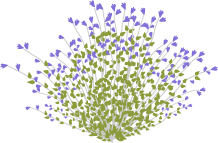 Shrubs
Shrubs
Select climate-appropriate plants. California native plants have evolved over time to thrive in our unique and varied climate conditions. Learn more about California native plants here.
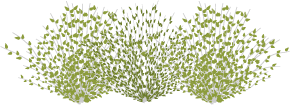 Groupings of Shrubs
Groupings of Shrubs
Grouping of shrubs should be designed from low density to high density as one moves farther away from the house. Create low fuel with hardscape such as gravel walkways or other hard materials, as well as ground cover (max. 6 inches high).
 Trees
Trees
Prefer ground covers and shrubs with occasional small tree in the Home Protection Zone.
Make sure your trees are trimmed and maintained to allow for horizontal and vertical spacing with your house and other plants or structures.
- If your tree is more than 18-feet high, it is recommended to remove all tree branches at least 6 feet off the ground for lone trees.
- If your tree is less than 18-feet high, it is recommended to remove all tree branches within the first 1/3 of the tree height.
Additional vertical spacing may be required if shrubs or bushes are planted under the tree. Take a look at the diagram below on proper spacing to learn more.
- Trees (either lone or grouping) should ideally be at least 10 feet of horizontal spacing between the branches of other trees or structures such as decks, garages, sheds. Additional spacing may be required on steep slopes.
Ensure Proper Spacing
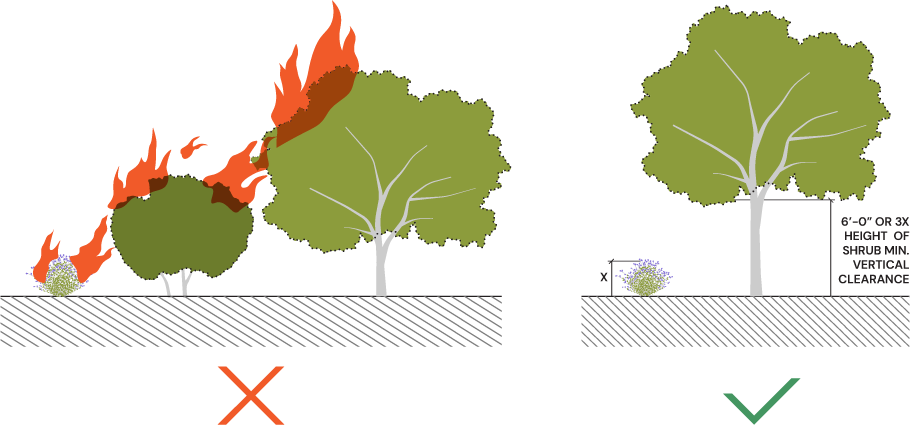
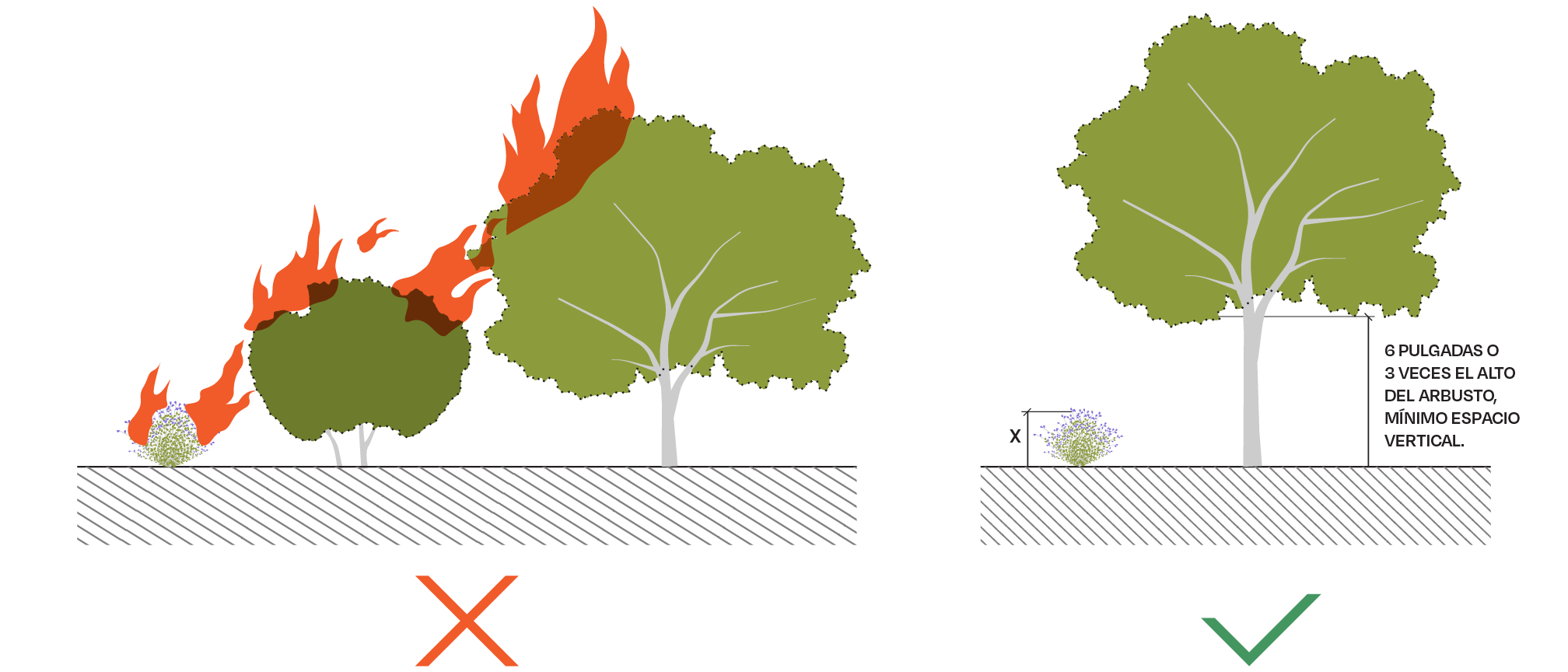
Laddering Effect
Plants protect soils from erosion and provide aesthetic and ecological benefits. Trees and shrubs are acceptable as long as they are widely spaced and do not provide a continuous path of fuel for a fire to climb from the ground to a tree crown or roof (a fuel ladder). Proper landscape maintenance can dramatically improve the fire safety of a yard. Remember to:
- Preserve single specimens or groupings of well-spaced and well-pruned trees or other vegetation.
- Eliminate ladder fuels within the defensible space zone by disrupting the vertical and/or horizontal continuity of plants.
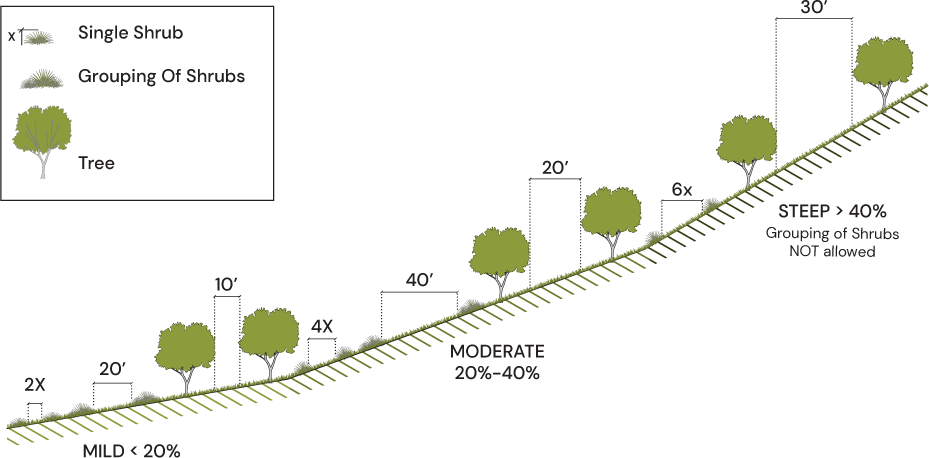
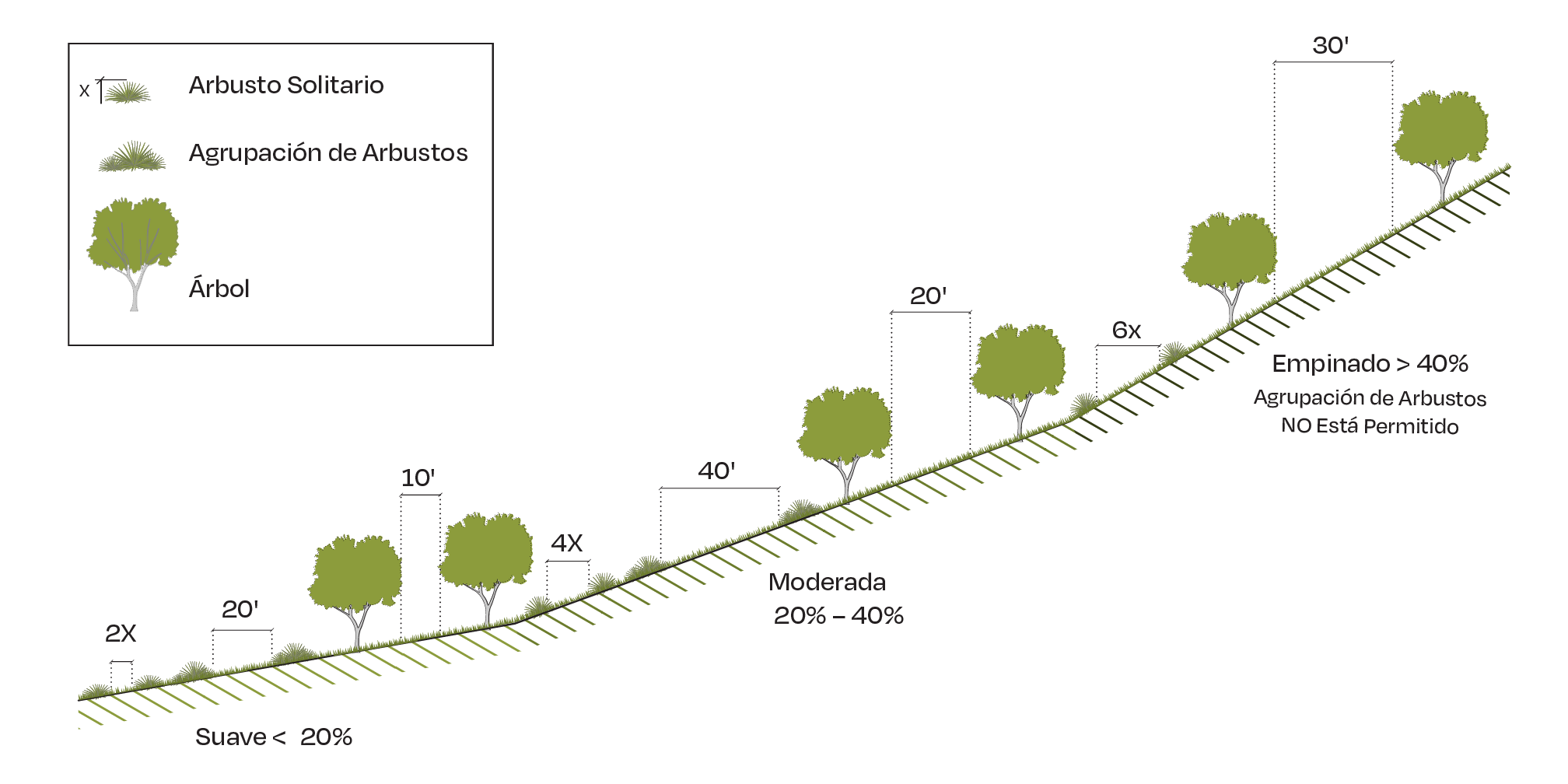
Spacing Guidelines on Slope
Hardscape: Designing Against Fire

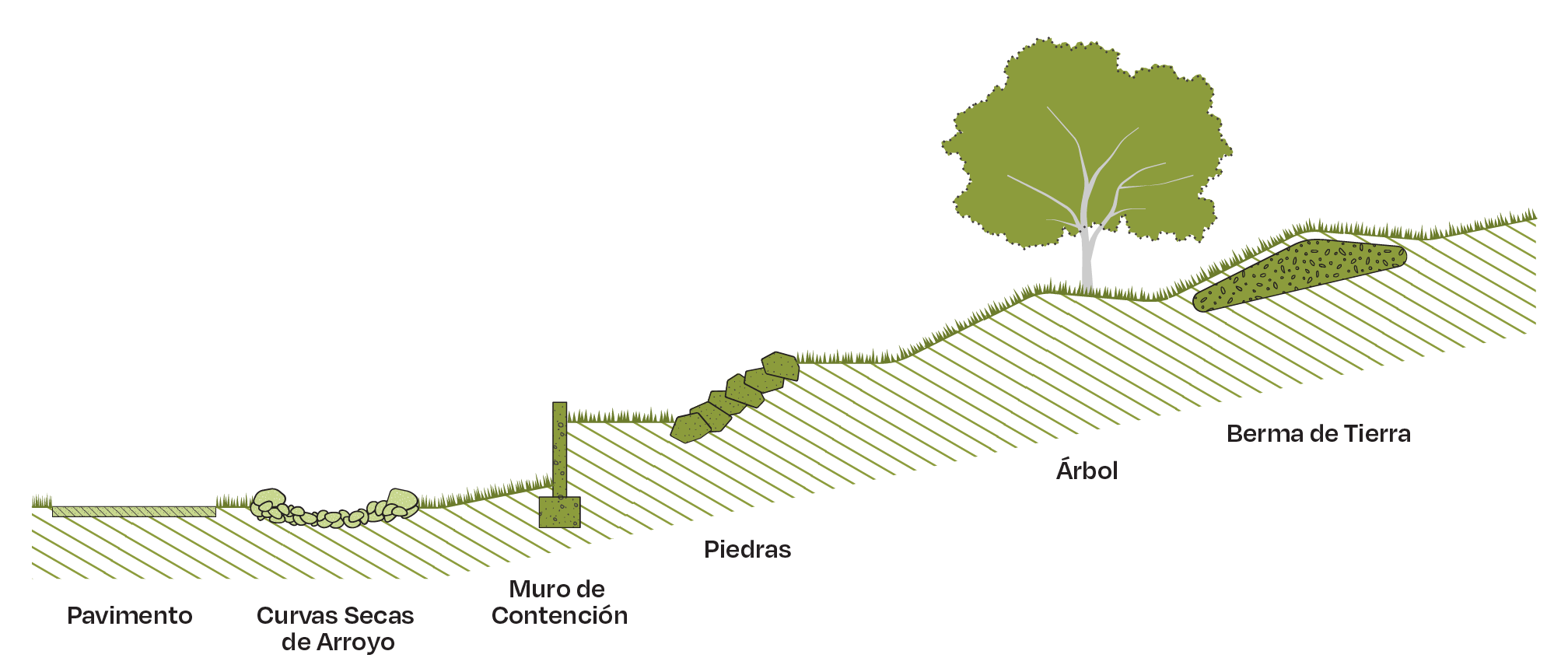
You can take advantage of multiple hardscaping solutions to protect against fire.
- Create islands of vegetation interrupted by non-flammable pathways, walls, or dry creek beds.
- Stabilize your slope with retaining walls or terracing. These structures can help break up fire-generated winds and stop embers from blowing along the ground.
Irrigation
For information about hydrozones (grouping plants by water needs) and smart irrigation systems, please see our Water & Irrigation section.
Environmental Considerations for Planting and Fuel Management
Do NOT remove vegetation down to bare soil, and do not destabilize hillsides by using heavy equipment; soil erosion and mudslides can result.
Some native plants are protected by California law. Important California laws for native plant protection are the California Endangered Species Act (CESA), the Native Plant Protection Act (NPPA), the California Environmental Quality Act (CEQA), the Natural Community Conservation Planning Act (NCCPA), the California Desert Native Plants Act (CDNPA), and California Penal Code Section 384a. Find more information about these regulations by clicking here.
For more information about these regulations and permits, please contact the Native Plant Program (California Department of Fish and Wildlife) at nativeplants@wildlife.ca.gov.
 Erosion
Erosion
Excessive clearing can lead to erosion, causing slope destabilization. Please consult Forestry Division or Brush Clearance Unit prior to starting work. More information about slope stabilization can be found here.
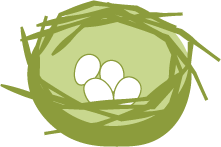 Endangered/Threatened Species and Migratory Birds
Endangered/Threatened Species and Migratory Birds
Restrictions exist that may impact when and where you may remove vegetation. Consult jurisdictional agencies, which may include National Park Service, State Parks, Mountains Recreation and Conservation Authority, California Department of Fish and Game, U.S. Fish and Wildlife Service.

Fire-Wise Planting
Use low fuel volume, fire-wise plants. See our section on Plant Characteristics.
 Invasive Species
Invasive Species
As part of their vegetation management activities, owners should not be planting invasive, and consider removing those that occur. For more information about invasive species, see our section on Invasive Species.
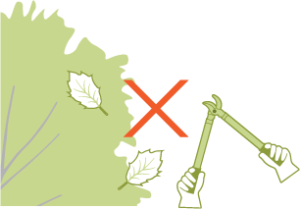 Oak tree pruning or removal
Oak tree pruning or removal
Subject to restrictions and ordinances. Consult the Environmental Review Unit for questions or permits. They can be reached at (818) 890-5719. You can find more information about oak tree ordinances in our section on Oak Woodland.
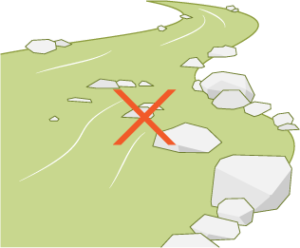 Streams
Streams
Restrictions impact activities near the bed, bank, and channel of a waterway. Consult the California Department of Fish and Wildlife for streambed alteration agreements. Click here for more information.
Defensible space is the area between your home and an oncoming wildfire. All vegetation, including native plants and ornamental plants, are potential fire fuel. Through proper planning, you can have both a beautiful native landscape and a fire-wise home. Fire-wise landscapes should also include hardscape, such as granite paths and stone walls. These can act as fuel break -in-between islands of native vegetation– and help to slow down or change the path of an approaching fire.
The Reduced Fuel / Thinning Zone
The Reduced Fuel / Thinning Zone has a dual function. It serves as a connection with the natural environment promoting habitat restoration while eliminating continuous, dense vegetation, to decrease the energy and speed of the wildfire. The Reduced Fuel / Thinning Zone supports habitat connectivity and wildfire discontinuity. Do NOT remove vegetation down to bare soil, and do not destabilize hillsides by using heavy equipment; soil erosion and mudslides can result. Follow recommended spacing guidelines.

* The size of the zones shown above are supported by research into home losses in wildfires, and are consistent with most local regulations at the time of publication. Based on this evidence and current CalFire standards, we show a maximum distance for native vegetation modification of 100′ from the house. However, the type of vegetation, terrain, and local regulations may require additional thinning beyond 100′. The Los Angeles County Fire Department may require up to 200’ of defensible space. Contact your local Fire Department for specific requirements.
Native vegetation is often protected by regulations, so do not remove previously unmodified habitat without first contacting your local County planning department for specific limitations and processes.
If you are neighboring a State Park or Protected Area, you may apply for a Boundary Vegetation Modification Right of Entry Permit (BVMROE) to address your desired defensible space. An approved permit allows homeowners or their contractor access to State Park land to trim vegetation within 130 feet of the closest habitable structure. To learn more about obtaining a State Parks BVMROE permit to complete defensible space for your home, contact California State Parks at info@parks.ca.gov.
Recommendations
 |
 |
Plant primarily native species within Zone 1 and 2. Native plant species support local ecosystems and wildlife. Learn more about native plants in our dedicated section. |
||
 |
 |
Non-native plant species that are not invasive may be allowed, although we recommend using primarily native species. Remove invasive plants. Click here for list of invasive species. |
||
 |
 |
Only use native plant species as you move outwards to support an ecological transition with the surrounding wildland. |
||
 |
 |
Remove invasive plants. Click here for the list of invasive species. |
||
 |

|
Plant species used within this zone should be consistent with Fire Department requirements. |
Plant Selection
Climate-appropriate Leaf Characteristics

California native plants have evolved over time to thrive in our unique and varied climate conditions. By learning to recognize their adaptation tricks, you can identify climate-appropriate plants wherever you are. These four characteristics will allow you to find climate-appropriate plants in a crowded nursery.
- Stiff, Leathery: These leaves hold on to water and stay evergreen for most of the year.
- Silver or Hairy: Light colored leaves reflect sunlight, cooling the plant. Hairy back sides of leaves hold moisture longer, cooling them off.
- Tiny or Little: Small leaves are like tiny solar panels that are easier to keep cool than one large hot surface.
- Solar Tracking: Leaves that appear to be standing at attention, straight up and down in the middle of the day, are solar tracking. As the day progresses, or if you see the same plant in the early morning, you will find that the leaves are more horizontally oriented. This plant is moving its solar panels to minimize the hottest sun exposure. California native manzanitas (Arctostaphylos) are notorious for this adaptation.
Click here for more information about California native plants.

Mulch
The use organic mulch is allowed within the Home Protection Zone.
- Prefer composted wood-chips from tree trimmings and plant material, it screens off weeds when applied as a layer 2” to 4” thick, reduces evaporation from the soil surface, cuts watering needs and promotes soil microorganism activity.
- Do NOT use rubber or plastic based mulch. Rubber mulch produces very high temperatures and flames when ignited. It ignites easily and burns intensely for a prolonged period. Learn more about the combustibility of different types of landscaping mulch here.
 Ground Cover
Ground Cover
- Plant high moisture content ground cover as you get closer to your house
- Max. 6 inches in height
- Can be used to create low fuel between shrubs and beneath trees.
- Cutting your lawn to no less than 4 inches high increases drought resistance allowing the grass the ability to regulate temperature and moisture, and form deeper roots.
 Shrubs
Shrubs
Select climate-appropriate plants. California native plants have evolved over time to thrive in our unique and varied climate conditions. More about California native plants here.
 Groupings of Shrubs
Groupings of Shrubs
Grouping of shrubs should be designed from low density to high density as one moves farther away from the house. Create low fuel with hardscape such as gravel walkways or other hard materials, as well as ground cover (max. 6 inches high).
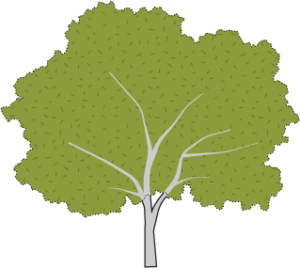 Trees
Trees
Make sure your trees are trimmed and maintained to allow for horizontal and vertical spacing with your house and other plants or structures.
- If your tree is more than 18-feet high, it is recommended to remove all tree branches at least 6 feet off the ground for lone trees.
- If your tree is less than 18-feet high, it is recommended to remove all tree branches within the first 1/3 of the tree height.
Additional vertical spacing may be required if shrubs or bushes are planted under the tree. Take a look at the diagram below on proper spacing to learn more.
- Trees (either lone or grouping) should ideally be at least 10 feet of horizontal spacing between the branches of other trees or structures such as decks, garages, sheds. Additional spacing may be required on steep slopes.
Ensure Proper Spacing


Laddering Effect
Plants protect soils from erosion and provide aesthetic and ecological benefits. Trees and shrubs are acceptable as long as they are widely spaced and do not provide a continuous path of fuel for a fire to climb from the ground to a tree crown or roof (a fuel ladder). Proper landscape maintenance can dramatically improve the fire safety of a yard. Remember to:
- Preserve single specimens or groupings of well-spaced and well-pruned trees or other vegetation.
- Eliminate ladder fuels within the defensible space zone by disrupting the vertical and/or horizontal continuity of plants.


Spacing Guidelines on Slope
Hardscape: Designing Against Fire


You can take advantage of multiple hardscaping solutions to protect against fire.
- Create islands of vegetation interrupted by non-flammable pathways, walls, or dry creek beds.
- Stabilize your slope with retaining walls or terracing. These structures can help break up fire-generated winds and stop embers from blowing along the ground.
Irrigation
For information about Hydrozones (Grouping Plants by Water Needs) and Smart Irrigation Water Systems, please see our Water & Irrigation section.
Environmental Considerations for Planting and Fuel Management
Do NOT remove vegetation down to bare soil, and do not destabilize hillsides by using heavy equipment; soil erosion and mudslides can result.
Some native plants are protected by California law. Important California laws for native plant protection are the California Endangered Species Act (CESA), the Native Plant Protection Act (NPPA), the California Environmental Quality Act (CEQA), the Natural Community Conservation Planning Act (NCCPA), the California Desert Native Plants Act (CDNPA), and California Penal Code Section 384a. Find more information about these regulations by clicking here. For more information about these regulations and permits, please contact the Native Plant Program (California Department of Fish and Wildlife) at nativeplants@wildlife.ca.gov.
 Erosion
Erosion
Excessive clearing can lead to erosion, causing slope destabilization. Please consult Forestry Division or Brush Clearance Unit prior to starting work. More information about slope stabilization can be found here.
 Endangered/Threatened Species and Migratory Birds
Endangered/Threatened Species and Migratory Birds
Restrictions exist that may impact when and where you may remove vegetation. Consult jurisdictional agencies, which may include National Park Service, State Parks, Mountains Recreation and Conservation Authority, California Department of Fish and Game, U.S. Fish and Wildlife Service.
 Fire-Wise Planting
Fire-Wise Planting
Use low fuel volume, fire-wise plants. See our section on Plant Characteristics.
 Invasive Species
Invasive Species
As part of their vegetation management activities, owners should not be planting invasive, and consider removing those that occur. For more information about invasive species, see our section on Invasive Species.
 Oak tree pruning or removal
Oak tree pruning or removal
Subject to restrictions and ordinances. Consult the Environmental Review Unit for questions or permits. They can be reached at (818) 890-5719. You can find more information about oak tree ordinances in our section on Oak Woodland.
 Streams
Streams
Restrictions impact activities near the bed, bank, and channel of a waterway. Consult the California Department of Fish and Wildlife for streambed alteration agreements. Click here for more information.
The Surrounding Wildland
The wildland and native habitat is the reason why people choose to live here, surrounded by the beauty of a natural habitat that provides critical ecosystem services by supporting native vegetation and wildlife. However, continued habitat loss and fragmentation threaten the long-term existence of many native species and pose the greatest threats to biodiversity. These threats remain acute in Southern California and more specifically in the most rapidly expanding urban areas in the United states such as the Los Angeles basin, Orange County, and the greater San Diego area.
We emphasize here two vegetation types that have been reduced and fragmented following human-caused disturbance. Contributing factors include development, excessive vegetation clearance, and too-frequent wildfires, all of which may result in invasion of nonnative weeds that produce lighter, more flammable fuels. As intact habitat is lost, the numbers of rare, threatened, and endangered species rise. These species contribute to biodiversity and serve extremely important roles in natural ecosystems. 149 plant and animal species that are rare, threatened, or endangered have the potential to occur in the Santa Monica Mountains.
When required by the Fire Department, this zone may require progressive thinning to lessen the spread of fire as it approaches the primary fuel modification zones. The amount of fuel reduction and removal should take into consideration the type and density of fuels, aspect, topography, weather patterns and fire history.

* The size of the zones shown above are supported by research into home losses in wildfires, and are consistent with most local regulations at the time of publication. Based on this evidence and current CalFire standards, we show a maximum distance for native vegetation modification of 100′ from the house. However, the type of vegetation, terrain, and local regulations may require additional thinning beyond 100′. The Los Angeles County Fire Department may require up to 200’ of defensible space. Contact your local Fire Department for specific requirements.
Native vegetation is often protected by regulations, so do not remove previously unmodified habitat without first contacting your local County planning department for specific limitations and processes.
If you are neighboring a State Park or Protected Area, you may apply for a Boundary Vegetation Modification Right of Entry Permit (BVMROE) to address your desired defensible space. An approved permit allows homeowners or their contractor access to State Park land to trim vegetation within 130 feet of the closest habitable structure. To learn more about obtaining a State Parks BVMROE permit to complete defensible space for your home, contact California State Parks at info@parks.ca.gov.
Recommendations
 |
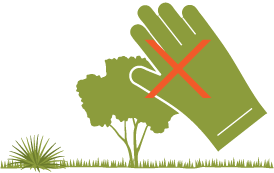 |
Do not modify vegetation (except removing identified invasive species) unless required by local Fire Departments. |
||
 |
 |
Learn how to recognize native and invasive species within your environment. Resources are available on PlantRight, California Native Plant Society, Theodore Payne Foundation and Calscape. |
||
 |
 |
Coordinate with your neighbors to create a community-wide fire-wise plan. More information in our Community section. |
||
 |
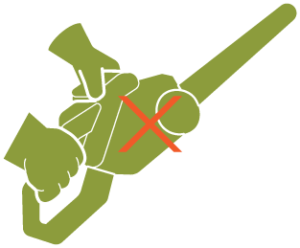 |
Do not remove vegetation down to bare soil, and do not destabilize hillsides by using heavy equipment; soil erosion and mudslides can result. |
Native Ecosystem
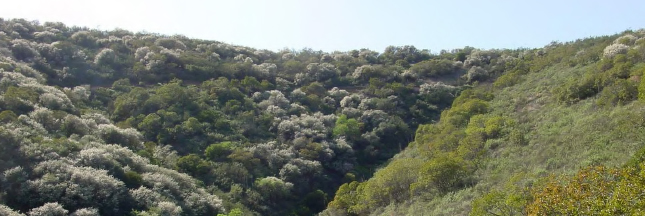
Chaparral and coastal sage scrub are the predominant vegetation types in the Santa Monica Mountains. Together with the climate they grow in, they can produce extreme fire behavior, yet these plant communities are among the most ecologically significant in Southern California. They possess exceptional watershed values, including soil stabilization and groundwater recharge. The valuable viewscapes they create make the region a popular place to live and visit. They also provide crucial habitat to many declining species of wildlife. These two vegetation types have been reduced and fragmented as a result of frequent and intense human-caused disturbance.
 Chaparral
Chaparral
Dominant chaparral species include small-leaved shrubs like chamise (Adenostoma fasciculatum) and ceanothus (Ceanothus spp). This plant community is found in foothill areas and requires 20 years after being severely disturbed to establish and produce sufficient seed for successful reproduction.
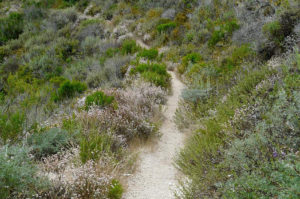 Coastal sage scrub
Coastal sage scrub
Coastal sage scrub includes soft, small shrubs under 3′ tall that grow below 2,500′ elevation. They include semi-woody aromatic evergreen plants such as California sagebrush (Artemisia californica), California buckwheat (Eriogonum fasciculatum), black sage (Salvia mellifera), and white sage (Salvia apiana).
This plant community is found on alluvial fans, bluffs, open range, and plains. Most wildlife species dependent on sage scrub require a minimum of 50 percent plant cover. Coastal sage scrub takes up to 2 to 3 years to regrow after a fire and a minimum of 10 years to recover following severe disturbance, such as complete removal.
Other key vegetation types in Southern California include subtypes of chaparral, oak woodland, riparian forest and shrubland, wetlands, and annual and perennial grasslands. Learn more about these habitats by consulting CNPS Fire Recovery Guide.
Learn more about about invasive and native plant species, as well as protected species by consulting our dedicated sections.
Slope Stabilization
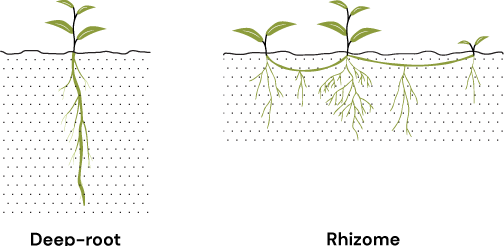
THE NATIVE “SOIL KEEPERS”
If you live in the Wildland Urban Interface, there is a chance you are surrounded by hills or uneven terrain. To help avoid erosion and runoff on your property, put in some native plants to stabilize the soils, control erosion and reduce your future irrigation costs. Moist and cool months are ideal to start these “soil keepers”. Once established they will require little irrigation. A mixture of plants is best, with various root depths to hold up a slope. In addition, a sprinkling of native seeds will add to the immediate coverage of your slope.
EXAMPLES
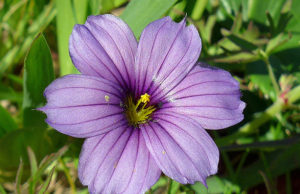 Blue-eyed Grass (Sisyrinchium bellum)
Blue-eyed Grass (Sisyrinchium bellum)
Delicate flowers, abundant from February to May, with grass-like leaves. A perennial, found naturally in grass meadows and other open places, re-seeds easily. A lovely addition to a dry border and does well in containers with well-draining soil. Likes sun to partial sun exposure. Foliage will die back in summer heat. 1’h x 1’w
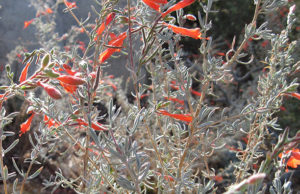
California Fuschia (Epilobium canum or Zauschneria californica)
A very hardy native that can take a lot of abuse, this is commonly found in dry areas, rocky slopes and cliffs. Abundant, scarlet tubular flowers from July to November, popular with hummingbirds. Likes sun to partial sun exposure, may be used as a ground cover. 2’h x 4’w
 California Redbud (Cercis occidentalis)
California Redbud (Cercis occidentalis)
An interesting plant year round, with beautiful pea-shaped magenta flowers on leafless stems in the spring, followed by interesting seedpods and heart-shaped bluegreen leaves. Deciduous, with yellow or red fall foliage on multi-branching stems. Prefers sun exposure. Excellent for dry, seldom watered banks. 20’h x 15’w
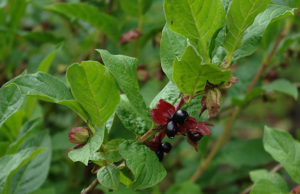 Twinberry Honeysuckle (Lonicera involucrata)
Twinberry Honeysuckle (Lonicera involucrata)
Prefers moist areas and pruning will keep size under control. Dense foliage with unique orange-red flowers that produce berries, attractive to birds. Blooms in the spring, drops leaves in winter. Sun to partial shade exposure. 6’h x 6’w
Managing Terraces
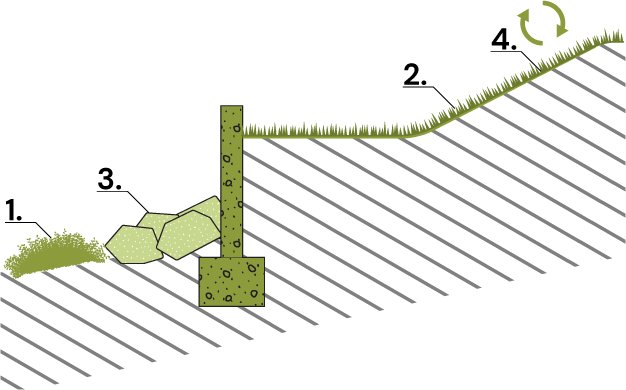
Terracing a slope can be great way to create a safer environment but terraces need to be maintained to avoid further erosion. The impermeable face of terracing structures can cause runoff and erosion as sheeting water undermines the base of the structure and increase topsoil loss. To avoid this problem, it is recommended to:
- Maintain a low-growing shrub at the base of the structure
- Maintain low-growing / ground-cover type of plants that can cascade over the terraces, offering protection from rainfall
- Install rip-rap at the base of the terrace to diffuse runoff and reduce topsoil loss
- Replace soil loss once a year by hauling it back up and compacting it.
Sources
California Native Plants for The Garden (2006) by C. Bornstein, D. Fross, and B. O’Brien. Cachuma Press.
California Watershed Approach to Landscaping (G3, 2018)
California Friendly Guide to Native and Drought Tolerant Gardens (Las Virgenes Municipal Water District, 2009)
Compost in a Hurry (UC ANR, 2007)
Defensible Space, Fire Retardant Landscaping, and Fire Hazard Reduction (UC ANR, 2020)
Fire Preparation Through the Year (UC ANR, 2020)
Fire Recovery Guide (California Native Plant Society, 2019)
Getting Started with Native Plants (Theodore Payne Foundation, 2015)
Mowing Your lawn and “Grasscycling” (UC ANR, 1999)
Native Planting Guides (California Native Plant Society)
Pruning Tips and Techniques (California Native Plant Society)
Roadmap to Fire Safety (SMMFSA, 2010)
S.A.F.E. Landscapes – Southern California Guidebook (UC ANR, 2009)
Starting a Native Plant Garden (California Native Plant Society, 2017)

